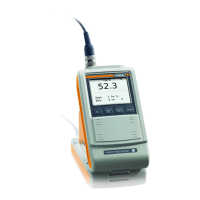
Do you have a question about the Fisher FERITSCOPE FMP30 and is the answer not in the manual?
| Measuring Principle | Magnetic induction |
|---|---|
| Accuracy | ± (0.5 FN + 1 % of reading) |
| Resolution | 0.1 µm (0 - 99.9 µm), 1 µm (100 - 3000 µm) |
| Display | LCD with backlight |
| Interface | USB |
| Operating Temperature | 0°C to 50°C |
| Application | Ferrite content measurement |
| Data Storage | Up to 1000 readings |
| Storage Temperature | -20°C to 60°C |
| Measurement Principle | Magnetic induction |
| Measurement Range | 0 - 80 FN or 0 - 110 %Fe |
| Probe Types | FGAB1.3 |
Explains symbols and conventions used in the manual for clarity and safety.
Specifies the purpose and scope of the FERITSCOPE® FMP30's application.
Outlines necessary qualifications and knowledge for users operating the instrument.
Details the correct procedure for connecting the instrument to a power source.
Provides instructions on how to handle the probe to prevent damage and ensure measurement accuracy.
Details the various elements and symbols shown on the instrument's display.
Describes the function of each key on the instrument's control panel.
Lists available accessories including probes and calibration standards.
Lists technical specifications of the instrument such as dimensions, weight, and power.
Explains the different ways to supply power to the instrument.
Details the procedure for connecting and disconnecting probes to the instrument safely.
Explains how to turn the instrument on and off, including power-up sequences.
Provides instructions and warnings for cleaning the instrument and accessories.
Gives guidance on how to hold and place the probe correctly during measurements.
Explains the process and necessity of registering or assigning a probe to the instrument.
Describes how to create and configure a new measurement application on the instrument.
Guides the user on how to choose an existing application for measurement.
Details specific settings for applications like tolerance limits and outlier rejection.
Explains the purpose of normalization and the required materials.
Explains the purpose and process of corrective calibration to adjust the calibration curve.
Explains the purpose of master calibration and the two types: factory and user.
Outlines the necessary steps to prepare the instrument and measurement area before taking readings.
Discusses factors like specimen curvature, thickness, and surface roughness affecting measurements.
Details the procedure for placing the probe and acquiring a measurement.
Explains how to use the CAL-Check function to verify instrument calibration and accuracy.
Explains how to view and interpret the statistical results of the current measurement block.
Explains how to view the overall results of all readings in the open application.
Explains how to connect the instrument to a PC using a USB cable.
Provides instructions for installing USB drivers on the PC for instrument connection.
Outlines the general procedure for transferring data to a computer.
Details how to send commands to the instrument from a PC for remote control.
Covers settings for language, time, date, brightness, light, auto-off, and re-initialization.
Explains settings for restricted operating mode, analog display, matrix mode, and linking applications.
Provides a table of common malfunctions, their causes, and correction steps.
Explains error and warning messages that may appear during instrument operation.
Explains common terms and symbols used in -ferrite content measurement.
Lists literature references for statistics, standards, and -ferrite content measurement.